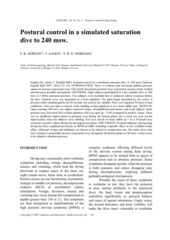Postural control in a simulated saturation dive to 240 msw.
Peer reviewed, Journal article
Published version
Permanent lenke
https://hdl.handle.net/1956/4842Utgivelsesdato
2007Metadata
Vis full innførselSamlinger
Sammendrag
INTRODUCTION: There is evidence that increased ambient pressure causes an increase in postural sway. This article documents postural sway at pressures not previously studied and discusses possible mechanisms. METHODS: Eight subjects participated in a dry chamber dive to 240 msw (2.5 MPa) saturation pressure. Two subjects were excluded due to unilateral caloric weakness before the dive. Postural sway was measured on a force platform. The path length described by the center of pressure while standing quietly for 60 seconds was used as test variable. Tests were repeated 38 times in four conditions: with eyes open or closed, while standing on bare platform or on a foam rubber mat. RESULTS: Upon reaching 240 msw, one subject reported vertigo, disequilibrium and nausea, and in all subjects, mean postural sway increased 26% on bare platform with eyes open (p < 0.05) compared to predive values. There was no significant improvement in postural sway during the bottom phase, but a trend was seen toward improvement when the subjects were standing with eyes closed on foam rubber (p = 0.1). Postural sway returned to predive values during the decompression phase. DISCUSSION: Postural imbalance during deep diving has been explained previously as HPNS possibly including a specific effect on the vestibulo-ocular reflex. Although vertigo and imbalance are known to be related to compression rate, this study shows that there remains a measurable increase in postural sway throughout the bottom phase at 240 msw, which seems to be related to absolute pressure.
Utgiver
The Undersea and Hyperbaric Medical SocietyOpphavsrett
The Undersea and Hyperbaric Medical Society.Copyright 2007 Undersea and Hyperbaric Medical Society. With permission from the Undersea and Hyperbaric Medical Society.
